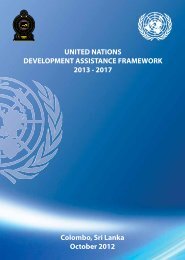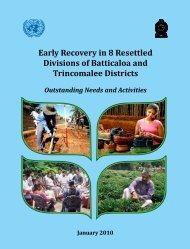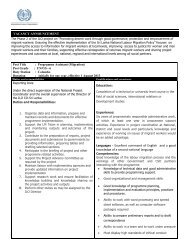Sri Lanka Human Development Report 2012.pdf
Sri Lanka Human Development Report 2012.pdf
Sri Lanka Human Development Report 2012.pdf
You also want an ePaper? Increase the reach of your titles
YUMPU automatically turns print PDFs into web optimized ePapers that Google loves.
Some of the primary reasons for women’s low labour force<br />
participation include the shortage of ‘good’ jobs and poor<br />
pay. Evidence indicates that women are paid less than men,<br />
a difference not explained by their productive capacity.<br />
Further, this was true in all sectors and irrespective of their<br />
ethnic background. This may be due to the occupational<br />
segregation of females in the private sector, but this is<br />
true even in the public sector where women benefit from<br />
gender-specific policies. 206<br />
In 2010, for women with A-Level education or above,<br />
the unemployment rate was 15.8 percent, compared to<br />
7.9 percent for men with similar qualifications. 207 While<br />
the proportion of women among professionals is higher<br />
than men, women constitute a smaller share at senior<br />
managerial levels. In both the public and private sectors,<br />
61.9 percent of employees are women, mainly the result<br />
of the large number of female school teachers. Among<br />
senior officials and managers, however, only 23.7 percent<br />
are women. 208 The share of women among senior officials<br />
in the public sector is also small. In the state, provincial<br />
public and semi-government sectors, females account for<br />
only around 28 percent of senior officials. 209<br />
Unlike their older male counterparts, women and youth<br />
are more likely to seek flexible working arrangements. For<br />
women, the reasons include the management of work at<br />
home, while youth may still be acquiring an education.<br />
However, opportunities for part-time employment are<br />
extremely limited. Overall, the employment situation is<br />
not helped by the country’s highly protective labour laws,<br />
which hinder job creation in both the public and formal<br />
private sectors. 210<br />
Job Creation and Quality of Jobs<br />
The <strong>Sri</strong> <strong>Lanka</strong>n economy has created new jobs at the same<br />
rate as the growth of the working age population - an average<br />
annual rate of 1.5 percent from 2000 to 2010. The labour<br />
force, defined as the economically active population, has<br />
grown at a slower pace of only 1.1 percent per year, mainly<br />
because of the ever-increasing outflow of workers seeking<br />
employment in foreign countries. Every year, an estimated<br />
270,000 people depart for foreign employment, compared<br />
to 20,000 who enter the labour market 211 Successive<br />
governments have relied upon outward migration as a<br />
source of both foreign capital and employment. 212<br />
Around 7.4 percent of <strong>Sri</strong> <strong>Lanka</strong>n households receive<br />
remittances from abroad. 213 Compared to households<br />
with no migrant workers, those with at least one have<br />
significantly higher levels of total expenditure on food<br />
and non-food items, including health and education.<br />
They also receive more income from other sources, such<br />
as properties, and financial and physical assets. But not all<br />
outcomes of migration are positive. A small percentage of<br />
households suffer adverse impacts, such as when children<br />
become unhappy and fall behind in school because their<br />
mothers are abroad. 214<br />
A high proportion of <strong>Sri</strong> <strong>Lanka</strong>n workers are in the<br />
informal sector, as has been true over time. 215 In 2010, for<br />
example, about 62.6 percent of employed people worked<br />
in the informal sector, which operates outside state<br />
regulation. They include 86.5 percent of the agricultural<br />
labour force and 51 percent of non-agricultural workers.<br />
In all districts, the share of non-agricultural workers in the<br />
informal sector was more than 39 percent.<br />
Around 42 percent of workers were either self-employed<br />
or unpaid family workers, categorized as vulnerable by<br />
the International Labour Organization. 216 It defines<br />
vulnerable workers as those who do not have formal work<br />
arrangements and therefore are less likely to be covered<br />
by social protection schemes. They are also more likely to<br />
have low levels of productivity, low earnings and difficult<br />
working conditions.<br />
Currently, most types of social protection are linked to<br />
employment, so formal sector workers tend to be better<br />
protected. This imbalance has been instrumental in<br />
increasing unemployment rates, as educated workers wait<br />
for better jobs in the formal sector without taking up<br />
available opportunities. 217 The proportion of workers in<br />
vulnerable employment declined only marginally from<br />
2000 to 2010.<br />
Recent data show that 7.5 percent of the employed were<br />
working poor, an improvement on the 2006-2007 figure of<br />
13.7 percent. 218 There are, however, disparities, especially<br />
Chapter 5 Bridging <strong>Human</strong> <strong>Development</strong> Gaps: Employment and Livelihoods 83






